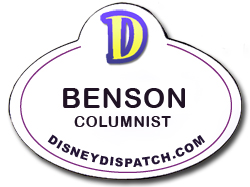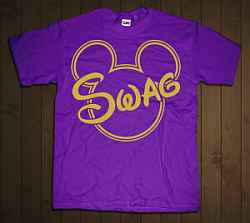FROM: It's All in a Nametag Published Thursdays
Classic Mickey Nametags
The more I read Benson Myer's column about Disney nametags, the more I think the subject is suitable for a college course. Today, Benson traces the history of the classic Mickey nametag and shares a tip for estimating nametag age.
Last week I told you that sometimes I feel like an amateur archaeologist as I pursue this silly hobby.
So today I want to give you some real Disney archaeology with a 'lesson' on the evolution of the classic Mickey Mouse nametag.
The tag was first introduced to Cast Members at both Disneyland and Walt Disney World in May 1978, and was used until around 2000. It became the default nametag when no particular special promotion or anniversary was being celebrated at the Parks.
Over the years, the nametag evolved through several versions.
Let's start with the first Disneyland version circa 1978:
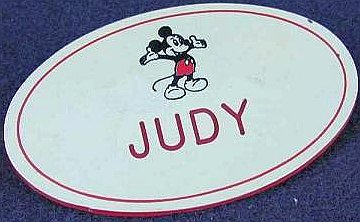
This version was in use until its retirement around 1989 in favor of a different rendering of Mickey Mouse with a new font created on a computer-controlled engraving machine:
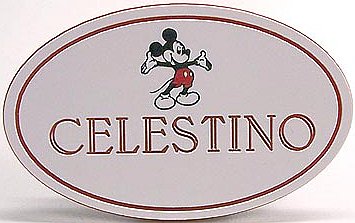
The font gained a more elegant double line.
Now, let's take a look at the Walt Disney World versions of the same Mickey nametag:
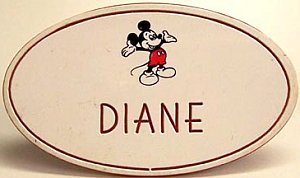
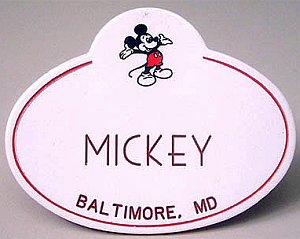
The Walt Disney World tag is slightly smaller in size, and uses what is 'affectionately' know as the Traditions font. This oval version at Walt Disney World was used from 1978 to about 1999, when the single bubble version was introduced.
When these nametags first arrived at Walt Disney World, a Cast Member applied the Mickey Mouse decal by hand with a heat gun, and then the entire nametag was clear-coated with a special sealant. I was told by a Cast Member who did this work that she burned her fingers on the heat gun more times than she cared to remember!
But let's get back on track.
You might have noticed that on the Disneyland versions, Mickey has shifted his pose slightly. Let's put them under the microscope for a closer look. We'll call the image on the left Version 1, the one on the right Version 2:
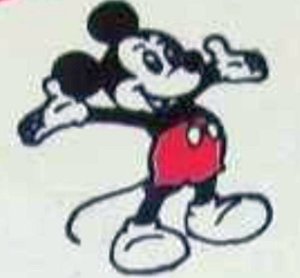
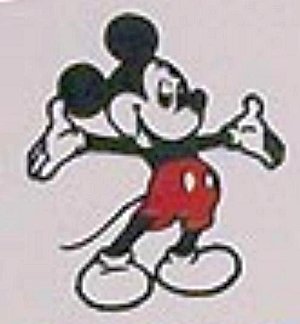
Here is the later version of Mickey from Walt Disney World (the 1978-1999 Disney World tags also used the design Mickey Version 1):
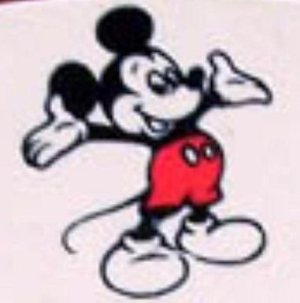
Notice the subtle changes to Mickey's ears, the distance of his left hand from his nose, and the position of his tail. Also, the red border is farther in from the edge on the Disneyland version than it is on the Walt Disney World version.
The same design was also used on nametags at the Walt Disney Studios in Burbank, California, during the same time period:
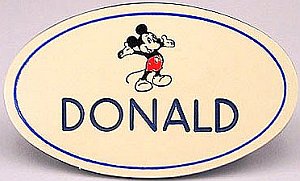
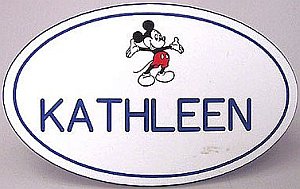
The border on these nametags is different. The red border identifed Cast Members from the Parks; the blue border identified those working at the Walt Disney Studios.
Dating Your Nametags
An easy way to determine the age of your nametags is to turn them over and see whether anything has been stamped into the back.
If you see '© Walt Disney Productions', your nametag dates to before 1986, as that was the year that Michael Eisner changed the name of the company. Hence, nametags made in 1987 or later will have '© The Walt Disney Company', the new name of the company.
Now, if someone comes up to you in an alley one dark and stormy night, and says, "Do you know anything about the old Mickey nametags used at Disneyland and Walt Disney World?", you can answer, "It just so happens that yes, I do".
And knowing is half the battle.
More: IT'S ALL IN A NAMETAG
Stuff Not to Skip
- Benson Myers' Blog
http://mousebadges.blogspot.com/2010/12/disney-store.html - Benson Myers' Nametag Museum
http://www.nametagmuseum.com




